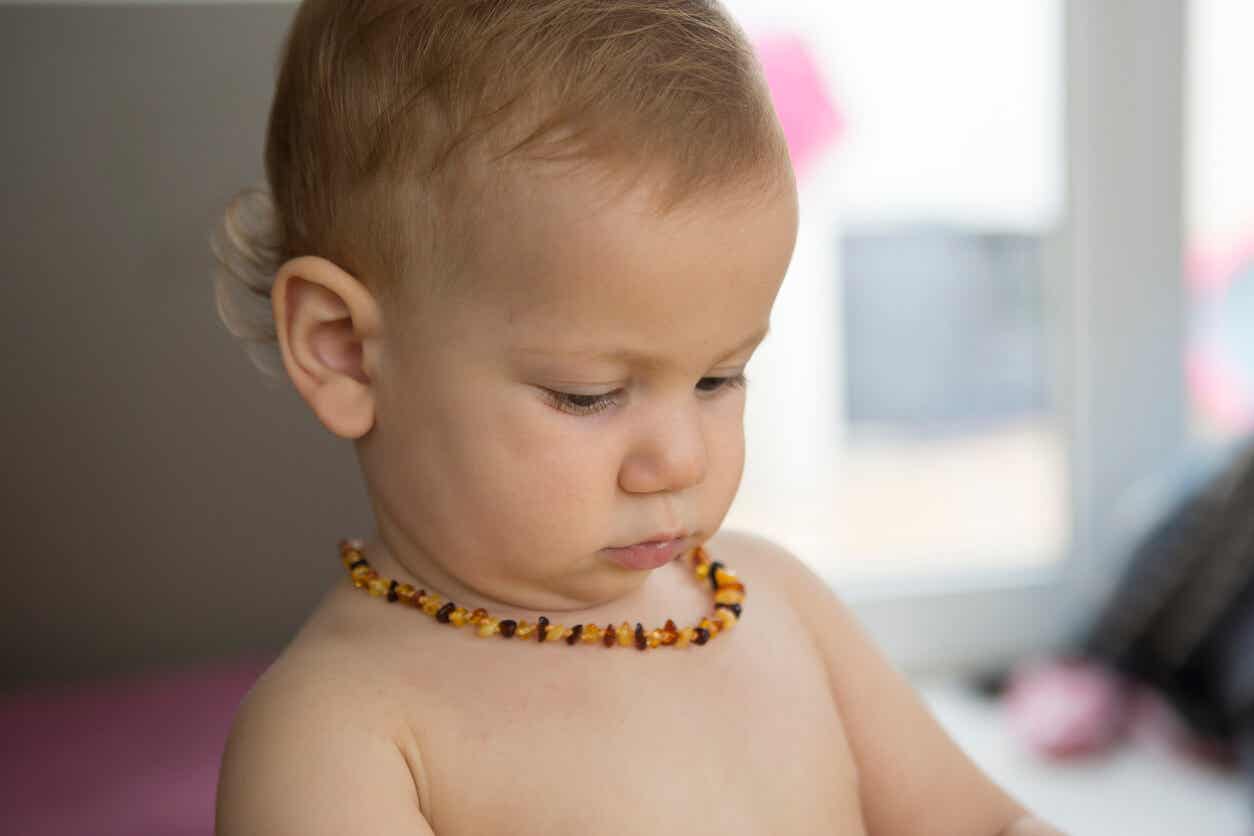Amber Necklaces for Teething: Myth or Reality?

The eruption of a child’s first teeth can be a very uncomfortable situation for the little one and somewhat stressful for their parents as well. For this reason, many adults resort to the use of amber necklaces to relieve teething pain. These consist of an elastic loop with small beads, which parents place around the infant’s neck during the teething stage.
Although it’s a trendy item right now, these necklaces have actually been around for several years. Sellers promote their consumption and use because of the supposed natural analgesic power of amber.
But besides the good parental intentions, it’s more important to consider the fact that these elements can be very dangerous for babies, and scientific societies don’t endorse their use. Keep reading to find out more.
Are amber necklaces for teething safe?
As we already said, experts warn against the use of amber necklaces to relieve teething pains in babies. The main reason is that they increase the risk of strangulation and suffocation in little ones.
Regardless of the material from which it’s made, placing a string around a child’s neck or leaving an object made of small beads within reach poses an enormous danger.
Do they work?
Many parents who like home remedies or naturopathic remedies find amber to be an attractive solution for pain. But it’s important to interpret the information that circulates about its use carefully, especially when it comes to elements that have gained such popularity.
It’s argued that the benefit of amber has to do with the succinic acid that the stone releases when it comes into contact with the baby. This skin then absorbs the substance, which supposedly acts as a natural anti-inflammatory for the gums.
Likewise, some amber supporters claim that this element stimulates the thyroid gland, the immune system, and the respiratory system. Some even attribute stress-reducing mechanisms to amber.

However, the truth is that there’s no proof for any of this. To this day, there’s no scientific evidence to support the supposed benefits of amber, including relief from teething discomfort.
While amber from the Baltic Sea is known to contain succinic acid, there’s no evidence that the skin absorbs this element when it reaches body temperature. And if this were to occur, the concentrations the skin absorbed would be too low to produce a significant therapeutic effect.
Are amber necklaces dangerous?
Besides the debate about their efficacy, it’s important to be aware of the risk associated with their use in infants and young children.
Anything tied around a child’s neck can cause death by strangulation. Also, a child can suffocate if any of the small amber beads enter their airway.
For these reasons, in many countries, these necklaces have been taken off the market and their use has been discouraged in children under 36 months of age.
Some manufacturers make claims that the pieces are made with beads of an appropriate size for children and that they’re tied in a special way so that they can’t fall off. However, scientific study has yet to determine their safety.
The American Academy of Pediatrics (AAP) doesn’t recommend the use of any jewelry or beads on infants. Nor does the U.S. Food and Drug Administration (FDA).

What’s a safe treatment option for relieving teething pains in babies?
As you’ve seen, resorting to amber teething necklaces isn’t a good idea. But this doesn’t mean there’s nothing you can do. There are other, safer ways to help babies during the eruption of their first teeth.
Here are some tips to keep in mind:
Offer your child teethers
There are many different types of teethers. Some are made of rubber, others of plastic or silicone. They come in different textures and their design aims to soothe and distract babies at this stage. In addition, you can cool some of them in the refrigerator, which provides even more relief for the baby.
Gently massage and stimulate their gums
Rubbing and pressing on red gums with clean fingers or knuckles is very helpful for soothing them. You can even do the same with the toothbrush during dental hygiene.
Prioritize fresh foods
If the child is already at the stage where they’re incorporating solid foods, offer different textures and try to make them cold or cool. With them, the baby will be able to stimulate and massage their gums to relieve pain. This should always take place under supervision in order to avoid choking.
Apply cold to the gums
Cold produces a numbing and anti-inflammatory effect on the gums. Offering objects or food cooled in the refrigerator will help calm your little one and provide greater comfort.
Use anti-inflammatory medications
If your baby’s very uncomfortable and the pediatrician deems it appropriate, you can offer an anti-inflammatory medication by mouth. Topical medications containing anesthetics aren’t recommended for young children.
Be patient and accompany your baby
Being able to accompany your baby with patience, supporting their routines with affection and lots of love is the most comforting thing for them.
Teething as part of growth
Tooth eruption is a normal and expected process for babies. And although for some children it can be very annoying, the truth is that it’s something tolerable and temporary.
Resorting to amber necklaces to reduce teething pains carries more risks than it does benefits. There are much simpler and safer methods to soothe your little one. Being able to accompany your baby with patience and love, trying to overcome this stage in a natural way, will be the best strategy to follow.
If you have any doubts or concerns about teething pains, the best thing to do is to go to your pediatrician. This way, you’ll be able to get advice on the best way to help your child cope with this process.
The eruption of a child’s first teeth can be a very uncomfortable situation for the little one and somewhat stressful for their parents as well. For this reason, many adults resort to the use of amber necklaces to relieve teething pain. These consist of an elastic loop with small beads, which parents place around the infant’s neck during the teething stage.
Although it’s a trendy item right now, these necklaces have actually been around for several years. Sellers promote their consumption and use because of the supposed natural analgesic power of amber.
But besides the good parental intentions, it’s more important to consider the fact that these elements can be very dangerous for babies, and scientific societies don’t endorse their use. Keep reading to find out more.
Are amber necklaces for teething safe?
As we already said, experts warn against the use of amber necklaces to relieve teething pains in babies. The main reason is that they increase the risk of strangulation and suffocation in little ones.
Regardless of the material from which it’s made, placing a string around a child’s neck or leaving an object made of small beads within reach poses an enormous danger.
Do they work?
Many parents who like home remedies or naturopathic remedies find amber to be an attractive solution for pain. But it’s important to interpret the information that circulates about its use carefully, especially when it comes to elements that have gained such popularity.
It’s argued that the benefit of amber has to do with the succinic acid that the stone releases when it comes into contact with the baby. This skin then absorbs the substance, which supposedly acts as a natural anti-inflammatory for the gums.
Likewise, some amber supporters claim that this element stimulates the thyroid gland, the immune system, and the respiratory system. Some even attribute stress-reducing mechanisms to amber.

However, the truth is that there’s no proof for any of this. To this day, there’s no scientific evidence to support the supposed benefits of amber, including relief from teething discomfort.
While amber from the Baltic Sea is known to contain succinic acid, there’s no evidence that the skin absorbs this element when it reaches body temperature. And if this were to occur, the concentrations the skin absorbed would be too low to produce a significant therapeutic effect.
Are amber necklaces dangerous?
Besides the debate about their efficacy, it’s important to be aware of the risk associated with their use in infants and young children.
Anything tied around a child’s neck can cause death by strangulation. Also, a child can suffocate if any of the small amber beads enter their airway.
For these reasons, in many countries, these necklaces have been taken off the market and their use has been discouraged in children under 36 months of age.
Some manufacturers make claims that the pieces are made with beads of an appropriate size for children and that they’re tied in a special way so that they can’t fall off. However, scientific study has yet to determine their safety.
The American Academy of Pediatrics (AAP) doesn’t recommend the use of any jewelry or beads on infants. Nor does the U.S. Food and Drug Administration (FDA).

What’s a safe treatment option for relieving teething pains in babies?
As you’ve seen, resorting to amber teething necklaces isn’t a good idea. But this doesn’t mean there’s nothing you can do. There are other, safer ways to help babies during the eruption of their first teeth.
Here are some tips to keep in mind:
Offer your child teethers
There are many different types of teethers. Some are made of rubber, others of plastic or silicone. They come in different textures and their design aims to soothe and distract babies at this stage. In addition, you can cool some of them in the refrigerator, which provides even more relief for the baby.
Gently massage and stimulate their gums
Rubbing and pressing on red gums with clean fingers or knuckles is very helpful for soothing them. You can even do the same with the toothbrush during dental hygiene.
Prioritize fresh foods
If the child is already at the stage where they’re incorporating solid foods, offer different textures and try to make them cold or cool. With them, the baby will be able to stimulate and massage their gums to relieve pain. This should always take place under supervision in order to avoid choking.
Apply cold to the gums
Cold produces a numbing and anti-inflammatory effect on the gums. Offering objects or food cooled in the refrigerator will help calm your little one and provide greater comfort.
Use anti-inflammatory medications
If your baby’s very uncomfortable and the pediatrician deems it appropriate, you can offer an anti-inflammatory medication by mouth. Topical medications containing anesthetics aren’t recommended for young children.
Be patient and accompany your baby
Being able to accompany your baby with patience, supporting their routines with affection and lots of love is the most comforting thing for them.
Teething as part of growth
Tooth eruption is a normal and expected process for babies. And although for some children it can be very annoying, the truth is that it’s something tolerable and temporary.
Resorting to amber necklaces to reduce teething pains carries more risks than it does benefits. There are much simpler and safer methods to soothe your little one. Being able to accompany your baby with patience and love, trying to overcome this stage in a natural way, will be the best strategy to follow.
If you have any doubts or concerns about teething pains, the best thing to do is to go to your pediatrician. This way, you’ll be able to get advice on the best way to help your child cope with this process.
All cited sources were thoroughly reviewed by our team to ensure their quality, reliability, currency, and validity. The bibliography of this article was considered reliable and of academic or scientific accuracy.
- de la Teja Ángeles, Eduardo. Erupción dentaria. (2019).
- Cox, Catherine, Neil Petrie, and Katrina F. Hurley. Infant strangulation from an amber teething necklace. Canadian journal of emergency medicine 19.5 (2017): 400-403.
- Abdulsatar, Farah, et al. Teething necklaces and bracelets pose significant danger to infants and toddlers.(2019): 132-133.
- Soudek, Lucy, and Robyn McLaughlin. Fad over fatality? The hazards of amber teething necklaces. Paediatrics & child health 23.2 (2018): 106-110.
- Abdulsatar, Farah, Sepideh Taheri, and Michael Miller. USE OF UNSAFE TEETHING REMEDIES IN A MID-SIZE CITY: A SURVEY. Paediatrics & Child Health 23 (2018): e54.
- Strieder, Anna Paola, et al. Digital behavior surveillance for monitoring the interests of Google users in amber necklace in different countries. International journal of paediatric dentistry 29.5 (2019): 603-614.
- Nissen, Michael D., et al. Baltic amber teething necklaces: could succinic acid leaching from beads provide anti-inflammatory effects? BMC complementary and alternative medicine 19.1 (2019): 1-9.
- Garcia, Jose Eduardo Baez, Vanessa Vargas-Alfaro, and J. Oscar C. Jimenez-Halla. Ámbar: una gema de interés comercial, histórico y químico. Naturaleza y Tecnología 3 (2019).
This text is provided for informational purposes only and does not replace consultation with a professional. If in doubt, consult your specialist.








